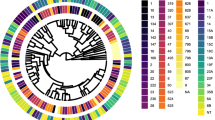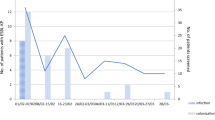Abstract
Surveillance of Streptococcus pneumoniae serotypes is important for the successful implementation of vaccination strategies to prevent the spread of invasive pneumococcal diseases. The standard method of serotyping of pneumococcal isolates is the phenotypic Neufeld test, which is cost- and labor-intensive. Recently, matrix-assisted laser desorption ionization-time of flight mass spectrometry (MALDI-TOF MS) has been implemented as a rapid, simple and inexpensive method for identifying species. We evaluated the performance of MALDI-TOF MS for serotyping ten major serotypes of S. pneumoniae in Japan (serotypes 3, 6B, 15A, 15C, 19A, 19 F, 23A, 24 F, 35B and 38) using the Biotyper and ClinProTools. After optimizing the settings, we validated their serotyping performance for serotypes 3, 15A and 19A using a separate set of isolates that were not used in the creation of the classification algorithms. A total of 574 isolates of S. pneumoniae collected from Japanese nationwide surveillance studies were included. Of these, 407 isolates belonged to the ten major serotypes. Biotyper and ClinProTools correctly identified 77.9 % and 84.0 %, respectively, of the ten major serotype isolates. The validation analysis included a total of 113 isolates of the serotypes 3, 15A and 19A isolates. Biotyper and ClinProTools correctly identified 85.0 % and 69.9 % of the validation cohort isolates, respectively. MALDI-TOF MS has the potential to discriminate the ten major S. pneumoniae serotypes prevalent in Japan.
Similar content being viewed by others
References
Mehr S, Wood N (2012) Streptococcus pneumoniae--a review of carriage, infection, serotype replacement and vaccination. Paediatr Respir Rev 13(4):258–264
Pichon B, Ladhani SN, Slack MP, Segonds-Pichon A, Andrews NJ, Waight PA, Miller E, George R (2013) Changes in molecular epidemiology of Streptococcus pneumoniae causing meningitis following introduction of pneumococcal conjugate vaccination in England and Wales. J Clin Microbiol 51(3):820–827
Ampofo K, Pavia AT, Chris S, Hersh AL, Bender JM, Blaschke AJ, Weng HY, Korgenski KE, Daly J, Mason EO, Byington CL (2012) The changing epidemiology of invasive pneumococcal disease at a tertiary children's hospital through the 7-valent pneumococcal conjugate vaccine era: a case for continuous surveillance. Pediatr Infect Dis J 31(3):228–234
Tan TQ (2012) Pediatric invasive pneumococcal disease in the United States in the era of pneumococcal conjugate vaccines. Clin Microbiol Rev 25(3):409–419
Parra EL, Ramos V, Sanabria O, Moreno J (2014) Serotype and genotype distribution among invasive Streptococcus pneumoniae isolates in Colombia, 2005–2010. PLoS One 9(1):e84993
Hu FZ, Eutsey R, Ahmed A, Frazao N, Powell E, Hiller NL, Hillman T, Buchinsky FJ, Boissy R, Janto B, Kress-Bennett J, Longwell M, Ezzo S, Post JC, Nesin M, Tomasz A, Ehrlich GD (2012) In vivo capsular switch in Streptococcus pneumoniae--analysis by whole genome sequencing. PLoS One 7(11):e47983
Sabharwal V, Stevenson A, Figueira M, Orthopoulos G, Trzcinski K, Pelton SI (2014) Capsular switching as a strategy to increase pneumococcal virulence in experimental otitis media model. Microbes Infect 16(4):292–299
Lund E, Rasmussen P (1966) Omni-serum. A diagnostic Pneumococcus serum, reacting with the 82 known types of Pneumococcus. Acta Pathol Microbiol Scand 68(3):458–460
Satzke C, Turner P, Virolainen-Julkunen A, Adrian PV, Antonio M, Hare KM, Henao-Restrepo AM, Leach AJ, Klugman KP, Porter BD, Sa-Leao R, Scott JA, Nohynek H, O'Brien KL (2013) Standard method for detecting upper respiratory carriage of Streptococcus pneumoniae: updated recommendations from the World Health Organization Pneumococcal Carriage Working Group. Vaccine 32(1):165–179
Clark AE, Kaleta EJ, Arora A, Wolk DM (2013) Matrix-assisted laser desorption ionization-time of flight mass spectrometry: a fundamental shift in the routine practice of clinical microbiology. Clin Microbiol Rev 26(3):547–603
Dubois D, Segonds C, Prere MF, Marty N, Oswald E (2013) Identification of clinical Streptococcus pneumoniae isolates among other alpha and nonhemolytic streptococci by use of the Vitek MS matrix-assisted laser desorption ionization-time of flight mass spectrometry system. J Clin Microbiol 51(6):1861–1867
Ikryannikova LN, Filimonova AV, Malakhova MV, Savinova T, Filimonova O, Ilina EN, Dubovickaya VA, Sidorenko SV, Govorun VM (2013) Discrimination between Streptococcus pneumoniae and Streptococcus mitis based on sorting of their MALDI mass spectra. Clin Microbiol Infect 19(11):1066–1071
Matsumura Y, Yamamoto M, Nagao M, Tanaka M, Machida K, Ito Y, Takakura S, Ichiyama S (2014) Detection of extended-spectrum-beta-lactamase-producing Escherichia coli ST131 and ST405 clonal groups by matrix-assisted laser desorption ionization-time of flight mass spectrometry. J Clin Microbiol 52(4):1034–1040
Nakano S, Matsumura Y, Kato K, Yunoki T, Hotta G, Noguchi T, Yamamoto M, Nagao M, Ito Y, Takakura S, Ichiyama S (2014) Differentiation of vanA-positive Enterococcus faecium from vanA-negative E. faecium by matrix-assisted laser desorption/ionisation time-of-flight mass spectrometry. Int J Antimicrob Agents 44(3):256–259
Mencacci A, Monari C, Leli C, Merlini L, De Carolis E, Vella A, Cacioni M, Buzi S, Nardelli E, Bistoni F, Sanguinetti M, Vecchiarelli A (2013) Typing of nosocomial outbreaks of Acinetobacter baumannii by use of matrix-assisted laser desorption ionization-time of flight mass spectrometry. J Clin Microbiol 51(2):603–606
Williamson YM, Moura H, Woolfitt AR, Pirkle JL, Barr JR, Carvalho Mda G, Ades EP, Carlone GM, Sampson JS (2008) Differentiation of Streptococcus pneumoniae conjunctivitis outbreak isolates by matrix-assisted laser desorption ionization-time of flight mass spectrometry. Appl Environ Microbiol 74(19):5891–5897
Isozumi R, Ito Y, Ishida T, Osawa M, Hirai T, Ito I, Maniwa K, Hayashi M, Kagioka H, Hirabayashi M, Onari K, Tomioka H, Tomii K, Gohma I, Imai S, Takakura S, Iinuma Y, Ichiyama S, Mishima M (2007) Genotypes and related factors reflecting macrolide resistance in pneumococcal pneumonia infections in Japan. J Clin Microbiol 45(5):1440–1446
Enright MC, Spratt BG (1998) A multilocus sequence typing scheme for Streptococcus pneumoniae: identification of clones associated with serious invasive disease. Microbiology 144(Pt 11):3049–3060
Griffin PM, Price GR, Schooneveldt JM, Schlebusch S, Tilse MH, Urbanski T, Hamilton B, Venter D (2012) Use of matrix-assisted laser desorption ionization-time of flight mass spectrometry to identify vancomycin-resistant enterococci and investigate the epidemiology of an outbreak. J Clin Microbiol 50(9):2918–2931
Park IH, Pritchard DG, Cartee R, Brandao A, Brandileone MC, Nahm MH (2007) Discovery of a new capsular serotype (6C) within serogroup 6 of Streptococcus pneumoniae. J Clin Microbiol 45(4):1225–1233
Acknowledgments
We are grateful to the members of the Pneumocatch surveillance study group and the Kansai Community Acquired Pneumococcal Pneumonia Study Group for their assistance with the collection of isolates. We are grateful to Michiaki Mishima for his management of these surveillance groups.
Conflict of interest
Yutaka Ito was supported by the research funding (WI 171133) from Pfizer for the surveillance study “Clonarity analysis of Streptococcus pneumoniae isolated from children with pneumococcal infection in Japan”. Takao Fujisawa was supported by an unconditional grant from Pfizer. Bin Chang, Makoto Ohnishi, and Toshiaki Ihara were supported by the Ministry of Health and Labour Sciences Research Grant (H22-shinko-shitei-021) and (H25-shinko-shitei-003).
All other authors declare no conflicts of interest.
Author information
Authors and Affiliations
Corresponding author
Electronic supplementary material
Below is the link to the electronic supplementary material.
Table S1
(DOCX 19 kb)
Rights and permissions
About this article
Cite this article
Nakano, S., Matsumura, Y., Ito, Y. et al. Development and evaluation of MALDI-TOF MS-based serotyping for Streptococcus pneumoniae . Eur J Clin Microbiol Infect Dis 34, 2191–2198 (2015). https://doi.org/10.1007/s10096-015-2468-9
Received:
Accepted:
Published:
Issue Date:
DOI: https://doi.org/10.1007/s10096-015-2468-9




